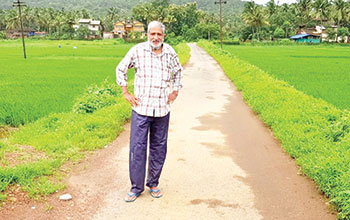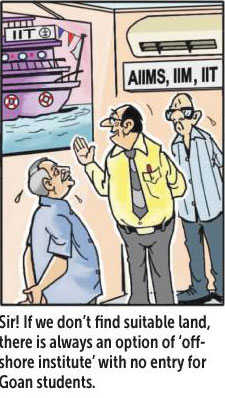
Team Herald
CURTORIM: Joao Rebello stands in the middle of the vast expanse of fields, sprayed with green in the middle of the verdant countryside of Maina and Curtorim.
Over yonder are the hills and the river Zuari beyond. As your eyes pan, the whole line of villages- Borim and Raia stretches endlessly. The air is absolutely fresh- fresher than any artificial bio-bubble.
While Rebello cultivates as much as 60,000 square metres of land, it is a parcel of 4,000 square metres, which is a patch of inspiration. It is here that Rebello has transplanted the traditional Patni variety of paddy, an attempt to give back to Curtorim the variety of rice, which made the village the granary of Salcete.
At the other end of the village, one of the villages biggest cultivators and leading lights of the village, Wonedulfo Da Costa, continues to wear the hats of an agriculturist, horticulturist and above all naturalist and is a guiding force to other cultivators and farmers.
Outside his hut, surrounded by pukka houses of his family members, the aged Antionio Fernandes aka Bhankar sits; a little away from his house, are patches of land where his produce of pumpkin, okra and other vegetables grow.
The three of them are Curtorkars. All have lived their lives in the villages. But now they have a connection that is stronger than they being village residents. A connection possible by the work of a 57-year-old exemplary Curtorkar, a bachelor boy, J Santan Rodrigues, wedded to the passion of reviving one identity that flows through the veins of Maina and Curtorim- agriculture.
Curtorim is nature’s sanitiser. And it is one of the villages in Goa, leading a quiet but definitive movement towards getting some back to the farms and others to enhance their productivity through innovation and enterprise; in a manner reminiscent of the olden days when the Comunidade managed agricultural activity, which made the village reliant and self-sufficient.
Rodrigues is the Chairman of the Village Biodiversity Management Committee but it’s not the title, which makes the man, it is the man who lends weight to that title. The Curtorim Union and farmers club within it, managed largely by Rodrigues, has united farmers, on hope and enterprise. And while the Comunidade exists as an institution but has lost its powers to the detriment of Goa “Our farms, lakes, plantations and orchards are connected and so are its people. The People’s Biodiversity register is a store house of village information, which allows us to pan activities for the protection of bio-diversity”, he says
Herald rode with him on his scooter through the village paths. In the middle of the breathtaking canvas of farms and fields, we stop. On the left of the road that cuts through the expanse of Sukrem in Curtorim on one side and Firgiabhat in Maina, he stood. Just him and the fields. Putting more areas under cultivation; getting the best deals for farmers; and getting the best seeds.
Not far from this spot are the fields of Joao Rebello and Michael Vaz. They have together revived what Curtorim missed for 25 years, the Patni variety of rice grown in the morod upper reaches of the village. The yield isn’t as high as the newer varieties but it’s the delicious rice all Curtorkars of that generation know and swear by.
“We decided to try this. Dr Pradip Sarmokadam, (Member Secretary of the Goa Biodiversity Board) encouraged us, arranged for the seeds and this will be our first crop,” they say.
Between Rebello and Vaz, the Patni paddy has been manually transplanted across 4,000 square metres of their fields, waiting for the harvest in October.
There is one unsung hero who has been helping them, Father George Quadros of Don Bosco, earlier in Loutolim and now Fatorda. He is the angel of Agriculture singlehandedly traversing the fields of Salcete, Sanguem, Quepem and others, transplanting seeds, helping farmers, both with knowledge and enthusiasm.
Wonedolfo Da Costa is a veteran and has seen it all. From the time that the Comunidade had a control over how farming was done in the village to now when there are no rules, conventions and methods of farming. He also laments that many of the fields are barren and fallow because there are fewer people on farms and the activity is done mainly by tenants from outside the village and non-Goan labourers. He himself had done more than his fair bit by using his farms for great yields, be it paddy coconuts or other fruit and vegetables. More importantly, if Rodrigues is the man on the ground, Da Costa is the father figure, a shepherd of farmers as it were. His inputs on water management, getting back the khazan lands for cultivation and improving yields is a constant source of input for the farmers club and the union.
The last stop and the last word, has to be for the treasure trove, a walking museum and a storehouse of history, Rafeal Viegas.
“Cultivation used to happen in three places or three layers as it were. The morod or the upper layers, the kher lands or addis, which was middle layer and the khazan lands by the river side. Tenants paid rent to the Comunidade. The rent was also calculated systematically where the cost of production and the profits thereof were arrived at. The rent or siddou was the income of the Comunidade, which was the income of the community. He laments that the lands are barren because families have become smaller and the next generation is “not on the fields”. The tenancy act has also meant that the Comunidade has no control over village matters.
What Santan Rodrigues and the villagers of Curtorim are doing is to try and course correct and bring the potential bounty of the 20 lakh square metres of cultivation back into the hands of the village and its people.
The addis, the morods and the khazan lands will thank these Curtorkars. So will Goa to this granary of Salcete by making provisions for its grandchildren and generations thereafter.
